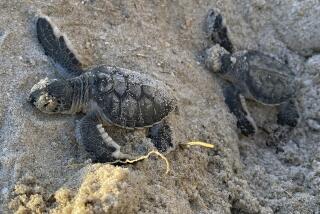In Sri Lanka, poachers become turtles’ protectors
- Share via
REKAWA, SRI LANKA — On a moonlit night, a group of young men huddled around a green turtle as it dug deep into a beach to lay its eggs.
They could hear the turtle breathing and grunting as it went into a trancelike state, dropping eggs the size of pingpong balls into a glistening pile. The men, once the village toughs, stood aside as the turtle finished, shoveling sand over the nest with its back flippers.
As a teenager, Phushara Weerawarna would have pounced on the nest as soon as the turtle left, eating some eggs raw and keeping the rest to sell illegally.
Now, he protects the turtle eggs and patrols the beach to keep would-be poachers at bay.
Weerawarna and more than a dozen other former nest-raiders work for the Turtle Conservation Project, a local group dedicated to safeguarding the turtle nests of Rekawa beach in southern Sri Lanka, where about 100,000 turtle eggs are buried each year.
“I definitely love them,” said Weerawarna, 27. “We like protecting them.”
This one-mile stretch of sand is one of the country’s most important nesting grounds for the endangered green turtle, and one of South Asia’s only beaches where five species of turtle nest.
The group’s community-based conservation philosophy is part of a worldwide shift toward connecting locals with their environment that experts say may offer the best chance for protecting endangered species.
Before the project was founded in 1993, the Rekawa nests were regularly picked clean by poachers who spent nights at the beach fighting over turtle eggs and drinking coconut liquor.
Yet instead of running the poachers out of town, the turtle experts hired them.
“They were considered to be the lowest of the low,” said Peter Richardson, a founder and British biologist with the Marine Conservation Society. “They were the wild boys of the village. It took a leap of faith.”
That leap has paid off for the turtles, whose hatchlings now make it to the sea, and it’s paid off for the former poachers.
Siripala Edisuriya poached eggs for 15 years, selling them to tea shops and market stalls. Now, he’s a nest patroller on the night shift. “It’s hard work, but I’m proud of what I do,” he said.
As a Buddhist, he is filled with guilt over his poaching days.
“It was a big sin,” said Edisuriya, the oldest of the group at 59. “I don’t know how long it will take to pay off that sin. I have to face my bad karma.”
It took three years for Richardson to persuade the men to protect the nests instead of raid them. There were long talks about conservation and biology. But it was the offers of steady salaries that won them over.
“It was just about the money to start with, but as the program developed their status improved,” said Richardson.
It was a rocky transition, one that a few poachers didn’t make. But most became patrollers, earning about $3 per shift, and then genuine conservationists.
The number of marine turtles is difficult to pinpoint, but green turtles are endangered and other species are even more vulnerable, said Brian Hutchinson, a marine turtle specialist with IUCN World Conservation Union.
“Overall, the population shows that the species are generally in decline, so there’s a lot of work to be done, but we’re seeing some positive steps,” he said.
South Asia is especially difficult for turtles because people have traditionally eaten them and their eggs, and because the region has many impoverished areas where conservation hasn’t taken root.
But increasingly, local projects similar to Rekawa have popped up across Asia and worldwide, Hutchinson said.
Rekawa is a perfect turtle-nesting beach. It’s undeveloped, without lights from homes or hotels to scare off turtles. In 2006, the beach was made Sri Lanka’s first marine-turtle sanctuary.
Experts estimate 200 to 300 turtles nest here, including leatherback, hawksbill, loggerhead and Olive ridleys. Most, though, are green turtles. Turtles lay eggs in clutches of about 100, which take about two months to hatch. One out of 1,000 turtles born here every year will survive to adulthood.
While the odds are long, the turtles’ chances are far better than they once were, or than at other beaches on this Indian Ocean island, where poachers still roam many nesting grounds that development hasn’t ruined.
Selling turtle eggs in the underground market remains common in Sri Lanka, though the government outlawed it in 1972. The eggs are believed to have health benefits, and they’re usually eaten raw or boiled.
Many poached turtle eggs in Sri Lanka end up in hatcheries, where tourists pay to see the hatchlings released to the sea. They usually release them during the day, not at night when they would naturally make for the ocean under cover of darkness. Experts say you can count the number of hatchery turtles released by the number of birds swooping down to snatch them.
The project hopes to attract tourists away from the hatcheries to Rekawa, where they can watch turtles lay eggs and, if they’re lucky, hatchlings leave the nest. But tourism in Sri Lanka has been hit hard by the December 2004 tsunami and an ever-worsening civil war.
The Turtle Conservation Project was founded by Thushan Kapurusinghe, the director, along with Richardson and his wife. Since then, the group has launched several turtle-protection projects in Sri Lanka. Richardson still works with the group, but it’s staffed by Sri Lankans, most from Rekawa.
They’ve adopted the conservation credo as their own.
“I have seen turtles and my children have seen turtles and I want my grandchildren to see them,” Edisuriya said.
More to Read
Sign up for Essential California
The most important California stories and recommendations in your inbox every morning.
You may occasionally receive promotional content from the Los Angeles Times.













